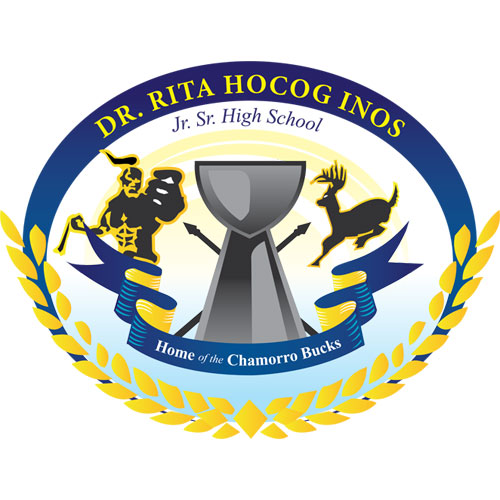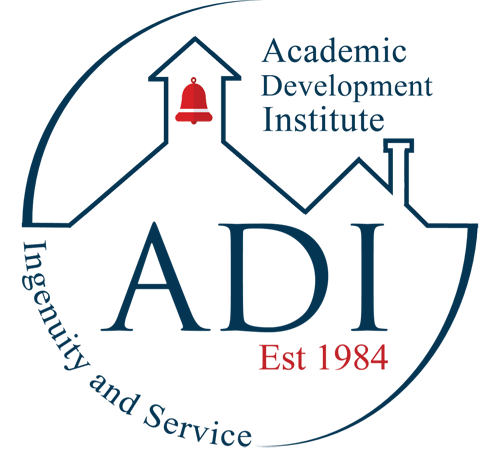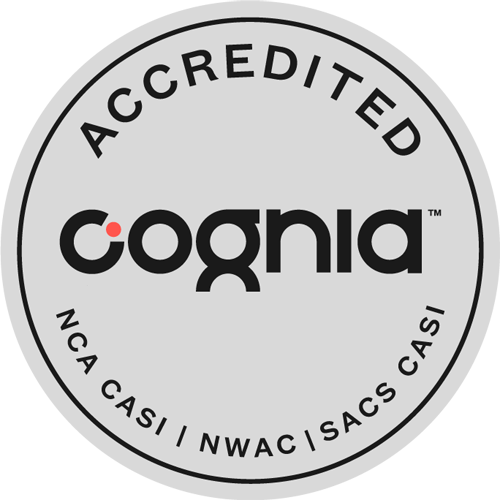Dr. Rita Hocog Inos Jr./ Sr. High School (RHI)
 School Mission
School MissionRHI will provide quality education in a nurturing and inclusive environment.
School Vision
Develop respectful, independent learners who possess the skills necessary to achieve success.
Executive Summary
Dr. Rita Hocog Inos Junior/Senior High School (RHI) has a population of 225 students in 7th-12th grade. Most students are indigenous Chamorros, followed by Filipinos, Bangladeshis, Chuukese, and Koreans. The two major languages spoken on the island are English and Chamorro. RHI is under the umbrella of the Commonwealth of the Northern Mariana Islands Public School System.
The population of Rota is around 1,900 people as of the last census. There has been a steady exodus for the past years due to limited job opportunities and no institution of higher learning. RHI has a Principal, a Guidance Counselor, two Administrative Staff, a Custodian, a Maintenance man, a School Aide, a Librarian Aide, a Health Monitor, seventeen teachers (to include one JROTC Instructor and one Leadership Corp Instructor), four Special Education Aides, and one Distance Education teacher aide. The majority of the faculty and staff were born and raised in Rota.
Due to the isolation and remoteness of the island, commodities and goods are two times the cost of our sister island. Attending professional development and meetings on Saipan entails a plane fare of $230.00 for a round trip. By Oct. 1 this year, the plane fare will increase to $330.00.
All instructional materials sent here add additional costs that adversely impact the money allocated to our school. The expensive airfare affects inequitable opportunities for our teachers and students since these activities are primarily in Saipan.
Despite the challenges we encounter, RHI is committed to the mission and vision of our school. RHI believes that quality education must center on students' unique needs, be relevant to their culture and life experiences, and prepare them with the knowledge and skills they need to contribute to their island and society.
In addition to the Board of Education mandated graduation requirements, each year, we conduct surveys to address the students' interests by offering their choice of electives. Due to pervasive poverty levels on islands, most students will enroll in Cooperative Education as it allows them to earn money and expose them to the world of work.
Since the inception of the Junior Reserve Officer Training Corp (JROTC) in 1993, this program has been a "shining star" and a popular elective. Students take great pride in wearing their uniforms and attending multiple community events where they serve as color guards and post and retired colors. The students have many opportunities to compete in off-island events and competitions.
Per capita, some more young men and women enter the armed forces from the Commonwealth of the Northern Mariana Islands. Joining the armed forces is particularly evident on the island of Rota, where most jobs are with the government, and the private sector offers minimal jobs with minimum wages. The military provides our students with opportunities to receive a higher education (which they could not otherwise afford) and venture into the world. JROTC provides an excellent foundation for students who will join the armed forces.
Our school district has procured the Holt, McMillan, and Harcourt (HMH) digital platform as the board-approved curriculum for English, Math, Science, and Social Studies instruction. HMH coaches provided teacher training and continuously provided coaching support in implementing the new digital learning platform.
As for assessment, the school administers the state-wide assessment: the Renaissance Star Reading and Star Math Assessment, the Standard Based Assessment for Science, Social Studies, and Chamorro Carolinian Heritage Studies, and the WIDA for English Language Learners. The results from the state-wide assessment inform teachers how to differentiate instruction to support students' skill levels. Instruction is meaningful and purposeful when students can see real-life connections to their lives.
Building relationships among students is critical. This school year, we are implementing Character Strong, a research-based K-12 social-emotional learning curriculum. Additionally, the administration invests in our teachers and students by providing them with professional development opportunities on Saipan and the states and engaging in personal and academic growth by attending classes and participating in competitions on the island, respectively.
Dr. Rita H. Inos Jr./Sr. High school is the namesake of one of the most renowned and respected educators in the Pacific Region who was raised and taught on Rota. We take great pride in maintaining her legacy by focusing on providing our teachers with the knowledge, skills, and competencies to be effective facilitators of learning who capitalize on students' individual needs and unique strengths and build on their weaknesses. Hence, they can pursue their dreams after they graduate.
| Grade Level | Grades 7-12 |
| Student Enrollment | 221 |
| Number of School Admin., Teachers, and Staff | 35 |
| Schoolwide Plan Allocation | $153,792.00 |
| Number of Objectives Met | In progress -up to SY 2024 |
| Number of Objectives Not Met | In progress -up to SY 2024 |
| Number of Completed Activities | 16 |
| Number of Lagging Activities | 7 |
RHI Schoolwide Plan Report
Our school identified three areas for our school-wide improvement plan, Language and Math Development, Social Emotional Learning, and Career Pathways. One of our primary objectives in language and math development is that 50% of students will increase one grade level by cohort. Based on the Star Reading and Math Assessments Outcomes, all grade levels decrease in percentage from at or above grade level. Therefore, the decrease in the rate at or above indicated that students did not increase one grade level by cohort. The impact of the activities identified in the language and math development did not increase Star Reading and Math as intended. Therefore, instructional leaders in the classroom must facilitate learning with fidelity and differentiate instruction based on individual students' ability levels to help students progress to one grade level on their star reading and math. All activities identified to support the critical initiative must be administered by the instructional leaders in the classroom with fidelity and accountability.
Regarding the Social Emotional Learning initiative, the activities identified that were successful this school year are the Youth Summit and the after-school enrichment programs. The Youth Summit was a success. Based on the Youth Summit Evaluation feedback, most students who participated in the evaluation survey indicated that the summit was worth their time. Based on the Cognia Surveys on Culture and Climate administered, our students indicated that seventy-six percent of students' interactions with adults are respectful and helpful, and seventy-five percent indicated that they are learning. The school also provided opportunities for students to join various afterschool programs based on their interest level. The homeroom advisory program is another program that allows students to develop relationships with trusted adults. During the homeroom advisory period, teachers facilitate learning activities by discussing students' Individual Education Plans, topics that affect students, sharing school activities and events with students, and other issues affecting our youth today.
With the Career Pathways initiative, there are several programs identified for students. The Tasi to Table students in this program gained knowledge and skills in the fishery. The school provided opportunities for students to join derby competitions. They were able to place in the competition. The Tasi to Table program is an essential part of students' opportunity to learn life skills and one day turn the skills they learn from this program into a career in the fishery industry.
Another pathway the school wanted to explore is the ACTE Career Vision Conference. Two administrative staff attended the ACTE Career Vision Conference; both gained knowledge of various CTE program platforms that may be implemented in the classrooms. For this program to succeed, training must be provided to the instructional staff facilitating the program modules in the school. CTE instructional leaders must assess the CTE program and identify modules relevant to our community that teachers can procure for implementation in a CTE Classroom.
As for the Arm Forces Pathway, our school counselor conducted a pre-ASVAB study group to prepare students for the test. As a result of the study group who studied for the test, sixteen out of the twenty-nine students who took the ASVAB exam passed the test. Three students who passed enlisted in the Air Force, and two are enlisting in the Coast Guard.
Our school's wide improvement plan was successful in some parts and challenging in others. This school year, the administration, faculty, and staff focus heavily on student social-emotional learning. This is why our survey on climate and culture indicated positive results. For the academic part, it is one of the causes of our Star Reading and Math Assessments Results' negative outcome because the focus is mainly on our students' social-emotional learning. What we know now is that RHI can plan to balance the education of students' social, emotional, and academic needs to address support for the whole child.
Successes
There were numerous successes during our school. One of the major successes is our 97% student graduation rate and 100% junior high school promotion rate. Another major success is the Youth Advisory Panel Summit held in the latter part of April. This summit was planned and facilitated by the YAP Student Organization, which addresses Social Emotional Learning topics. The students facilitated the presentations, which addressed issues they faced. These presentations were all student-led. Another major success is the Cultural Festival in the first week of May. Students formed a cooperative group to research cultures from different countries and present their findings during the Cultural Festival. The cultural festival is a Project Based Learning activity for students. Some Students from our feeder school, Sinapalo Elementary School, joined the celebration. Also, our Leadership Corp students, consisting of 7th and 8th graders, competed in Saipan and won 1st Place. Another success is one of our junior students passed the Certified Nursing Assistant Program (CNA) and was given the opportunity for a paid internship at Rota Health Center. Six of our students who are in the Entrepreneurship Program passed the Entrepreneurship Certification administered by Island Training Solutions. Three students have been accepted into the NMTech Summer Program and Internship Program with the PSS Central Office. One student this summer was also accepted into the CNA program.




